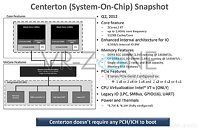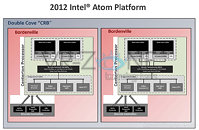Tuesday, December 27th 2011

Intel Centerton Atom A True Single-Chip SoC
Intel has, in the past, referred to its two-chip low-wattage computing solutions as "SoC" (system on a chip), keeping with that trend, it was assumed that "Centerton", an Atom-derived processor for NAS servers that the company is working on, could be a similar 2-chip solution with the tiny NM10 PCH sitting next to the CPU. It is now coming to light that Intel will design Centerton to run as a true single-chip SoC, without the PCH.
Centerton's core and uncore components, housed on the same piece of silicon, are detailed in the first picture, below. It packs two x86-64 cores. Each core has 32 KB L1I cache, 24 KB L1D cache, and 512 KB of dedicated L2 cache. There is no shared tertiary cache between the cores, however, they converge at the integrated memory controller (IMC). This IMC can control a single DDR3 memory channel, supporting 1.5V DDR3 UDIMMs with ECC support or 1.35V DDR3 SO-DIMMs, at speeds of PC3-10600 (DDR3-1333 MHz). Up to 8 GB of RAM is supported. The core can be clocked as high as 1.60 GHz. It features HyperThreading technology, enabling four logical CPUs for the OS to deal with. Any current 32-bit or 64-bit x86-capable OS should run.The uncore component lacks a display controller, but features a PCI-Express 2.0 root complex with 8 lanes, which can be configured as 1*x8, 2*x4, 4*x2, or 8*x1, with some mix-match configurations being possible. This can then directly connect to storage, ethernet, and USB controllers of the NAS device. The uncore also features SMBus 2.0, and high-speed UART. Lastly, there are legacy I/O connections, such as LPCIO to the SuperIO chip, GPIO, etc.) The processor supports virtualization, but limited to VT-x capabilities. A fully-configured Centerton chip should draw 5.7W of power, with a TDP of 8.1W.
Sources:
VR-Zone, MyDrivers
Centerton's core and uncore components, housed on the same piece of silicon, are detailed in the first picture, below. It packs two x86-64 cores. Each core has 32 KB L1I cache, 24 KB L1D cache, and 512 KB of dedicated L2 cache. There is no shared tertiary cache between the cores, however, they converge at the integrated memory controller (IMC). This IMC can control a single DDR3 memory channel, supporting 1.5V DDR3 UDIMMs with ECC support or 1.35V DDR3 SO-DIMMs, at speeds of PC3-10600 (DDR3-1333 MHz). Up to 8 GB of RAM is supported. The core can be clocked as high as 1.60 GHz. It features HyperThreading technology, enabling four logical CPUs for the OS to deal with. Any current 32-bit or 64-bit x86-capable OS should run.The uncore component lacks a display controller, but features a PCI-Express 2.0 root complex with 8 lanes, which can be configured as 1*x8, 2*x4, 4*x2, or 8*x1, with some mix-match configurations being possible. This can then directly connect to storage, ethernet, and USB controllers of the NAS device. The uncore also features SMBus 2.0, and high-speed UART. Lastly, there are legacy I/O connections, such as LPCIO to the SuperIO chip, GPIO, etc.) The processor supports virtualization, but limited to VT-x capabilities. A fully-configured Centerton chip should draw 5.7W of power, with a TDP of 8.1W.


8 Comments on Intel Centerton Atom A True Single-Chip SoC
same deal as consoles, with lower powered hardware a specially designed OS was needed to save system resources to get movie playback/flash etc working properly.
this is why W8 might be a good thing, as would x86 android - it could really shake up how OS's are designed and run on desktops, giving us a lot more bang for our processing power.